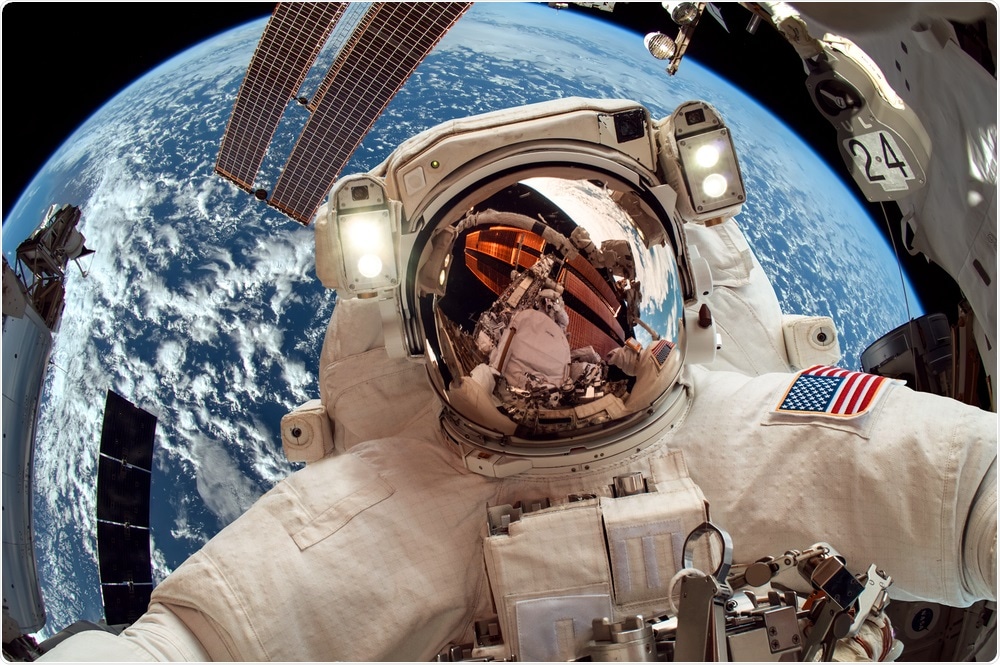The International Space Station (ISS) may have a mold problem. A new study shows that mold spores are present inside the station and may also survive on the outside walls of the spacecraft.
 Andrey Armyagov | Shutterstock
Andrey Armyagov | Shutterstock
The astronauts aboard the space station spend numerous hours every week cleaning inside the spacecraft’s walls to prevent mold formation and the health problems associated with it. However, a new study, presented at the 2019 Astrobiology Science Conference, showed that mold has been found growing on the walls of the ISS, revealing its natural presence in the station.
Aside from that, the researchers found that mold can survive incredibly high doses of ionizing radiation. This means that these molds aren’t just pesky problems on Earth, but can also live in space, despite the presence of radiation.
Mold on the ISS could spell trouble. In fact, mold problems should become one of the focus of the space agency, to ensure the health of its constituents. Molds have been linked to various diseases, such as respiratory problems and allergic reactions.
Since molds form spores that are easily spread through the air, they can easily contaminate habitats, and eventually, they might unintentionally contaminate other planets during colonization and exploration missions.
Fungal spores can withstand higher doses of radiation
To test if fungal spores can live in space, the researchers exposed them to various kinds of radiation – ultraviolet, X-ray, and heavy ions, in a controlled setting. As a result, they found that the fungal spores can withstand higher doses of radiation than expected. In fact, they can possibly survive space travel.
Two most common types of molds found on the space station are Penicillium and Aspergillus. These molds can survive and tolerate X-ray exposure, which is 200 times the dose of that would kill a human being.
Normally, these mold species aren’t harmful, but when inhaled in large amounts, they can cause serious respiratory disease, particularly for vulnerable populations, including people with weakened immune systems, pregnant women, older adults, and children.
What's more, molds are naturally resilient. They can withstand extreme temperatures, chemicals, dry conditions, and even ultraviolet light.
We now know that [fungal spores] resist radiation much more than we thought they would, to the point where we need to take them into consideration when we are cleaning spacecraft, inside and outside. If we're planning a long duration mission, we can plan on having these mold spores with us because probably they will survive the space travel."
Marta Cortesão, Microbiologist, The German Aerospace Center (DLR)
Molds love moist areas and habitats. Humans are moist creatures and if they’re placed in an enclosed spacecraft, the moisture will be transferred to the walls. Though the International Space Station is a controlled environment, with humans in it, it can become damp and moist, which is conducive for mold formation and proliferation.
Is space travel safe?
The new study could pave the way for scientists to create new protocols that can help prevent exploring spacecraft from contaminating other planets. Since these planets have not been exposed to these microorganisms, fungal spores may be considered a serious threat.
The researchers, however, reiterated that fungi aren’t that bad. In fact, the researchers said that these microorganisms can be considered as biological factories for certain materials. These include those needed to build polymers, produce food, vitamins, and other important compounds that can be used by astronauts during long space travels.
However, the researchers couldn’t test for other space conditions like extreme temperature and vacuum. Hence, further research should be carried out on mold spores and how to get rid of them to prevent contamination on other planets or moons.
How do fungi and mold affect the body?
Mold is common, but the potential problems are more serious than expected. Molds and fungal spores have been linked to untoward health effects in humans, such as allergies, infections, and respiratory diseases.
On Earth, molds grow almost anywhere – schools, homes, and buildings. But, the research has shown that these microorganisms can also live in space. Among astronauts, since they’re living in a contained space, exposure to molds can negatively impact their health.
Mold exposure may cause allergic reactions, including rashes, watery eyes, wheezing, runny nose, coughing, itchy eyes, and redness of the eyes. People with underlying respiratory disease, the symptoms can worsen when exposed to molds, like obstructive lung disease and pneumonia.
Journal reference:
Moeller, R., and Fujimori, A. (2019). The resistance of bacterial spores to space radiation – from wow to how? 2019 Astrobiology Science Conference. https://agu.confex.com/agu/abscicon19/meetingapp.cgi/Paper/479567.